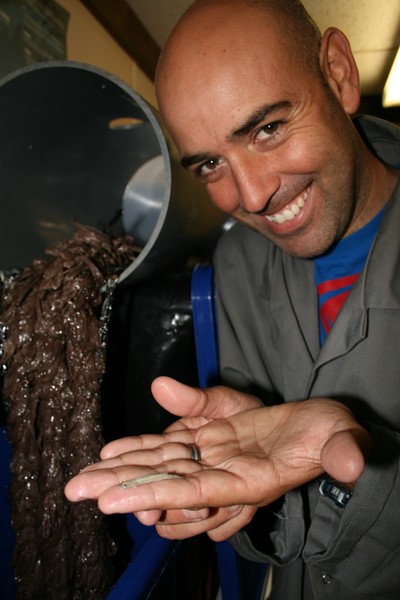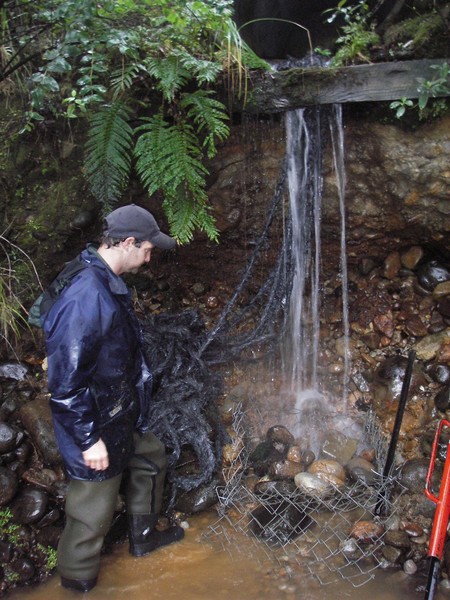Scientists discover whitebait can climb ropes
In what is believed to be a New Zealand first, Environment Waikato scientists may have found a clever way to overcome resource consent barriers for farmers – and possibly help to save some of New Zealand’s threatened native fish species.
http://www.youtube.com/watch?v=7NYja8ARhzA
Tiny fish climbing ropes – it might sound like a crazy idea from a Dr Seuss book, but it’s actually a real-life experiment being carried out by Environment Waikato scientists.
The scientists, Bruno David, Kevin Collier and Mark Hamer, have discovered juvenile banded kokopu, a native whitebait species, can climb up a special type of polypropylene rope.
Now they are conducting field trials to see if the fish can do the same thing in the natural environment and use their “climbing skills” to wriggle up ropes threaded through perched culverts.
Culverts are large pipes that allow water to pass underneath roads and farm tracks. “Perched” culverts hang above water level, blocking fish migration through rivers and streams.
“Fish need to be able to migrate up rivers as part of their life cycle so they can reach suitable adult breeding habitats,” Dr David said.
“Unfortunately, even well installed culverts can end up blocking fish passage over time, because the water rushing through erodes away the land away the end of the culvert. This can leave the culvert hanging above the stream, creating a drop that fish just can’t get past.”
This, along with habitat loss and substantial recreational harvesting nationally, was probably why reported whitebait catches had been steadily declining in the Waikato from an estimated average of 46 tonnes per year in the 1930s to around only three tonnes per year today, he said.
The scientists’ rope-climbing idea uses the knowledge that some native New Zealand fish species from hilly or steep river habitats are equipped with “their own version of four-wheel drive”.
“Some juvenile native fish have this unique ability to climb by flattening out their bodies and wriggling up using their heads and fins,” Dr David said.
“But even four-wheel drive can’t get them past a manmade structure like a perched culvert – to do that they’d have to climb upside down to negotiate the overhang, basically defying gravity.
“We’re hoping the rope could help them climb up to the culvert entrance and get past the lip.
“Providing fish access through just one culvert could open up kilometres of habitat upstream.”
Dr David said the rope could be an extremely cost effective way of retrofitting culverts to allow fish passage, eliminating the need for expensive engineered structures like fish ladders, which could cost tens of thousands of dollars.
Additional information for journalists
Pohutukawa inspiration
Dr David and Dr Collier came up with the rope idea while working in the field in 2007.
“We found a waterfall where roots were coming out of a big pohutukawa tree and growing over a big rock wall, down through the water,” Dr David said.
“When we peeled the roots open we found a whole lot of little eels and banded kokopu inside. We’d seen fish climbing rock walls before but we’d never seen them climbing up roots and we thought this might be a solution to the perched culvert problem, where we could use ropes rather than building expensive engineered structures like fish ladders.”
Early experiments successful
The scientists have already tested their idea using a replica culvert set up in an Environment Waikato laboratory last November. They used banded kokopu – one of five different native fish species that can make up a whitebait catch – captured during last year’s whitebait run.
For the experiment, they sourced a special kind of polypropylene rope used by the aquaculture industry to grow mussel spat. The durable furry ropes have loops and strands that fish leverage off as they wriggle up.
The trial worked, showing the juvenile fish could easily shimmy up half a metre of rope (the average height of a Waikato perched culvert) and use it to get through the replica culvert.
Field experiments underway
Experiments in the field have just got underway.
Two weeks ago the scientists installed ropes in a perched culvert believed to be blocking eel passage into Lake Harihari, south of Kawhia, and last week they installed the rope in a culvert that is blocking fish migration through a Coromandel stream.
They are hoping to improve fish passage for a range of “climbing” whitebait species, including koaro and the threatened giant and shortjaw kokopu. The rope should also work for juvenile redfin bullies, shortfin and longfin eels.
“The giant and shortjaw kokopu are as important as the kiwi or the kakapo, because they’re endemic to this country,” Dr David said.
“They’re not found anywhere else in the world.”
Big benefits for farmers
Even though the Resource Management Act requires all stream structures to allow fish passage, Dr David estimates there are possibly hundreds of perched culverts restricting fish passage across the Waikato region, many on farms.
Fish ladders – engineered structures – can be retrofitted to culverts to help fish migrate through, but these can be very expensive, involving expert input from biologists, engineers and other consultants.
If the rope idea works, it could be a cost-effective alternative to fish ladders in steep catchments where native climbing species are found, saving money for farmers, roading companies, councils and private land owners.
Scientific first
Dr David believes the technique could be a scientific first.
“I’ve looked long and hard and I can’t find any published documentation on the use of ropes to provide fish passage. I’ve heard a few anecdotes but I’ve never seen the technique in use.
“A similar approach using a tube with bristles inside has been used for enabling eel migration past some structures but the benefits of the rope are that it also provides structure inside the culvert pipe itself, rather than simply being a pathway to the pipe.”
Did you know?
Although the majority of whitebait is made up of inanga, a non-threatened native species, some species in the catch may include the threatened shortjaw and giant kokopu – so many New Zealanders have probably consumed threatened native species while eating their whitebait patties without even realising it.


